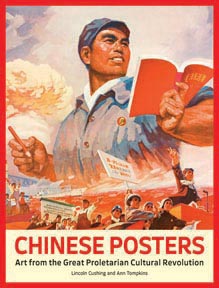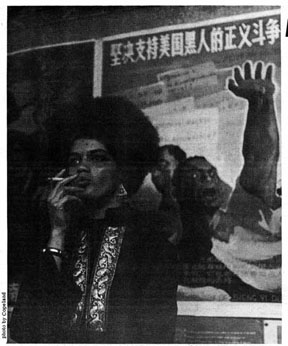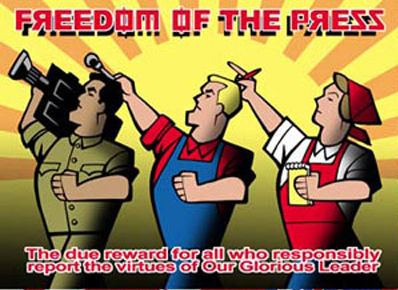by Lincoln Cushing and Ann Tompkins

The
Cultural Revolution in China produced thousands of powerful social and
political posters exhorting the Chinese people in a sweeping
transformation of Chinese society. These brilliantly colorful images of
cultural celebration, industrial development, agricultural production,
and revolutionary heroes were displayed in homes and public spaces
across the country. Chinese Posters collects 170 of these
posters and offers background on their social and political context and
production. An essay by Ann Tompkins provides a personal account of
living in Beijing during the Cultural Revolution.
Lincoln Cushing is the author of Revolución: Cuban Poster Art and is the editor of Visions of Peace & Justice: 30 years of political posters from the archives of Inkworks Press, He lives in Berkeley, California. Ann Tompkins lived and worked in Beijing during the Cultural Revolution. She lives in Santa Rosa, California.
$19.95 pb • Chronicle Books, 2007
ISBN-13: 978-0-8118-5946-2
8 x 10 1/2 in, 144 pp, Please patronize local bookstores near you if you can, or order through the Powell's Books worker's union site.
Also see Ann Tompkins (Tang Fandi) and Lincoln Cushing Chinese Poster Collection, East Asian Library, U.C. Berkeley, and related article Red All Over in VOICE, American Institute of Graphic Arts magazine, and full TRIKONT interview with Black Panther Party members (portion cited in book).
Interview 10/22/2007 KUCI radio, moderated by host Dan Tsang.
Chapters:
"Revolutionary Chinese Posters and Their Impact Abroad" by Lincoln Cushing
"People, Poverty, Politics, and Posters" by Ann Tompkins
Nature and Transformation
Production and Mechanization
Women Hold Up Half the Sky
Serve the People
Solidarity
Politics in Command
After the Cultural Revolution
Bibliography
Index of posters by title
Excerpt from "Revolutionary Chinese Posters and Their Impact Abroad,"
chapter on "Artwork in China During the Great Proletarian Cultural
Revolution (GPCR)" by Lincoln Cushing
During the GPCR the arts, including posters, were defined by several guiding political principles:
1. Rejection of Western and classical Chinese styles.
The GPCR sought to build a new socialist nation without reliance on the
values of foreign societies or previous corrupt domestic ones. This
meant striving to create new, modern Chinese forms. Although the
general style of Socialist Realist propaganda art was adopted from the
Soviet Union and taught in most of the Chinese art schools, the Chinese
worked to make the art and rhetoric uniquely their own.
2. Developing artwork from previously disenfranchised social strata and regions. Formally
trained artists were thought likely to harbor revisionist values (ones
not supportive of fundamental class struggle), and a huge effort went
into finding and supporting art by people who were workers, peasants,
and soldiers. To a more limited degree, the GPCR encouraged art about
and by ethnic minorities.
3. Rejection of “art for art’s sake.” Art styles narrowed to a slim range of Socialist Realism,
without abstraction or modernism. Art was expected to have some sort of
productive social function or application. Artists did not sign their
work, though most did get individual or collective published credit.
Some scholars have described the GPCR as representing a “lost chapter”
of Chinese art history because of the narrow range of officially
accepted forms (few media besides posters and theater were allowed) and
the view that Party politics trumped artistic creativity. There are
numerous examples of artwork destroyed, academic departments
dismantled, personal careers ruined, and even imprisonment and death.
Yet there are alternate views of the GPCR that recognize some of its
positive contributions to art and culture, especially within the
complicated trajectory of the Chinese revolution and its deep-seated
class antagonisms. In spirit, many of these goals were laudable. For
example, many countries struggle to keep their domestic arts production
from being overwhelmed by foreign commercial media culture; even a
modern Western democracy such as Canada has a national radio broadcast
policy requiring that a percentage of its content be generated
domestically. The state-sponsored encouragement of artmaking by
ordinary citizens is a democratic ideal, one fostered in the United
States during the 1930s by the Works Progress Administration’s Federal
Art Project. And the concept that art should not be divorced from
social needs and practice is a matter of long-standing debate within
the art world, one hardly unique to the GPCR. Academic studies in this
field are still rare, and given the polarized nature of the issues it
is assured that future analysis will continue to be characterized by
many differences of opinion.
Excerpt from "Revolutionary Chinese Posters and Their Impact Abroad," chapter on "Chinese Poster Resonance with Movement Communities" by Lincoln Cushing
The Chinese revolution and its visual depiction in posters inspired many people around the world, for a variety of reasons. Without even knowing the details of Chinese events, viewers could appreciate some of these posters as rare positive depictions of disenfranchised communities building a new society. From the students making posters during the May 1968 Paris uprising to the Black Panthers in the United States, groups outside of China paid close attention to the GPCR and its artistic output. These posters served as influential cultural tokens during the 1960s and ’70s, reinforcing the revolutionary spirit of numerous communities struggling for self-identification and social change.
Kathleen Cleaver, the communications secretary for the Black Panther Party from 1967 to 1971, remembers the posters distinctly:
Because China is so far away, we saw very few posters. What was
influential was a style, a Chinese style. By 1967 there was a sense
that Chinese art was reaching out to the African liberation movement
and to the Black liberation movement, at the same time that we were
getting in touch with their art. During the Cultural Revolution, few
activists and revolutionaries in the U.S. had a really clear
appreciation of Chinese history—they read things that Mao wrote and
they read things written about Mao. But it was the GPCR and the
posters, along with other things coming out of China at the time, that
were part of the ‘vibe.’ They were ubiquitous—they symbolized the
height of revolution. That’s enough. We didn’t have all the details.
We’ll never get all the details.
(Excerpt from author interview, August 2006)

Kathleen Cleaver, San Francisco Black Panther Party office, 1968
Photograph in Berkeley Barb by Alan Copeland

Kirk Anderson, http://kirktoons.com/busheviks/busheviks.html
Return to Docs Populi - Documents for the Public